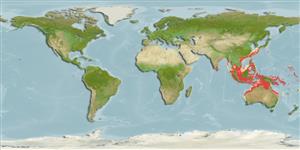Environment: milieu / climate zone / depth range / distribution range
Ökologie
seewasser demersal. Tropical
Western Pacific: Taiwan and the South China Sea to Australia (Darwin to North West Cape).
Size / Gewicht / Alter
Maturity: Lm ? range ? - ? cm
Max length : 20.0 cm SL Männchen/unbestimmt; (Ref. 9774); common length : 12.5 cm SL Männchen/unbestimmt; (Ref. 9774)
Rückenflossenstacheln (insgesamt) : 0; Rückenflossenweichstrahlen (insgesamt) : 68 - 72; Afterflossenstacheln: 0; Afterflossenweichstrahlen: 52 - 55; Wirbelzahl: 33 - 35. Body uniformly brownish, 2 ocelli above and below lateral line and 1 ocellus on posterior third of straight section of lateral line. Many indistinct rings scattered on body and median fins. Teeth in upper jaw small and close-set with3 or 4 pairs of canines anteriorly, teeth in lower jaw stronger and more widely spaced than those in upper jaw. Gill rakers pointed and rather short. Pectoral fin on ocular side with 12-13 rays (Ref 9774).
Inhabits deep waters on mud and sand bottoms of the continental shelf (Ref. 9774). Feeds on benthic animals (Ref. 4896). Marketed fresh and salt-dried (Ref. 9774).
Life cycle and mating behavior
Maturities | Fortpflanzung | Spawnings | Egg(s) | Fecundities | Larven
Distinct pairing (Ref. 205).
Sainsbury, K.J., P.J. Kailola and G.G. Leyland, 1985. Continental shelf fishes of the northern and north-western Australia. An illustrated guide. CSIRO Division of Fisheries Research; Clouston & Hall and Peter Pownall Fisheries Information Service, Canberra, Australia. 375 p. (Ref. 3131)
IUCN Rote Liste Status (Ref. 130435)
Bedrohung für Menschen
Harmless
Nutzung durch Menschen
Fischereien: kommerziell
Tools
Zusatzinformationen
Download XML
Internet Quellen
Estimates based on models
Preferred temperature (Ref.
123201): 24.3 - 29, mean 28 °C (based on 1590 cells).
Phylogenetic diversity index (Ref.
82804): PD
50 = 0.5000 [Uniqueness, from 0.5 = low to 2.0 = high].
Bayesian length-weight: a=0.00631 (0.00374 - 0.01065), b=3.12 (2.97 - 3.27), in cm total length, based on LWR estimates for this species & Genus-body shape (Ref.
93245).
Trophic level (Ref.
69278): 3.5 ±0.37 se; based on food items.
Widerstandsfähigkeit (Ref.
120179): hoch, Verdopplung der Population dauert weniger als 15 Monate. (Preliminary K or Fecundity.).
Fishing Vulnerability (Ref.
59153): Low vulnerability (14 of 100).
